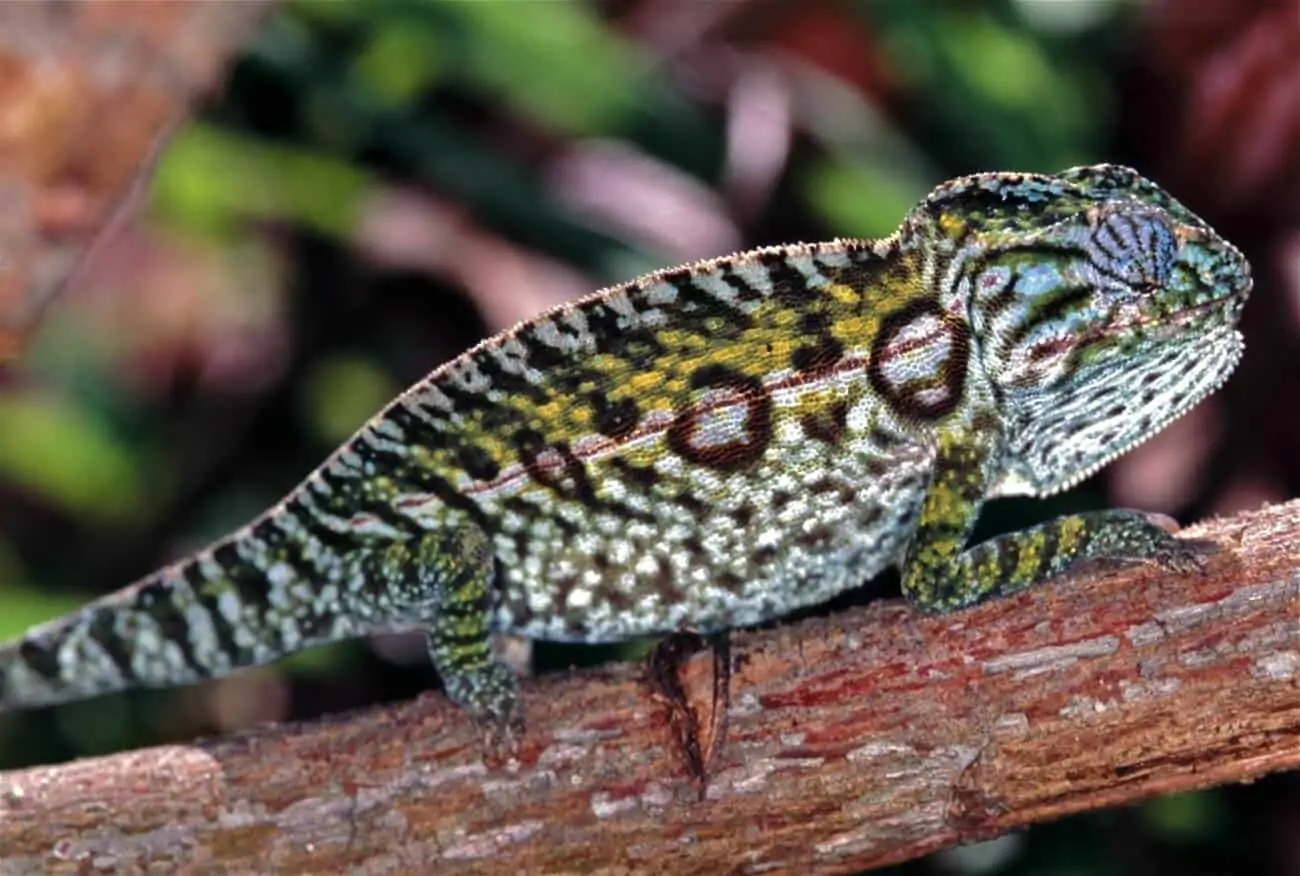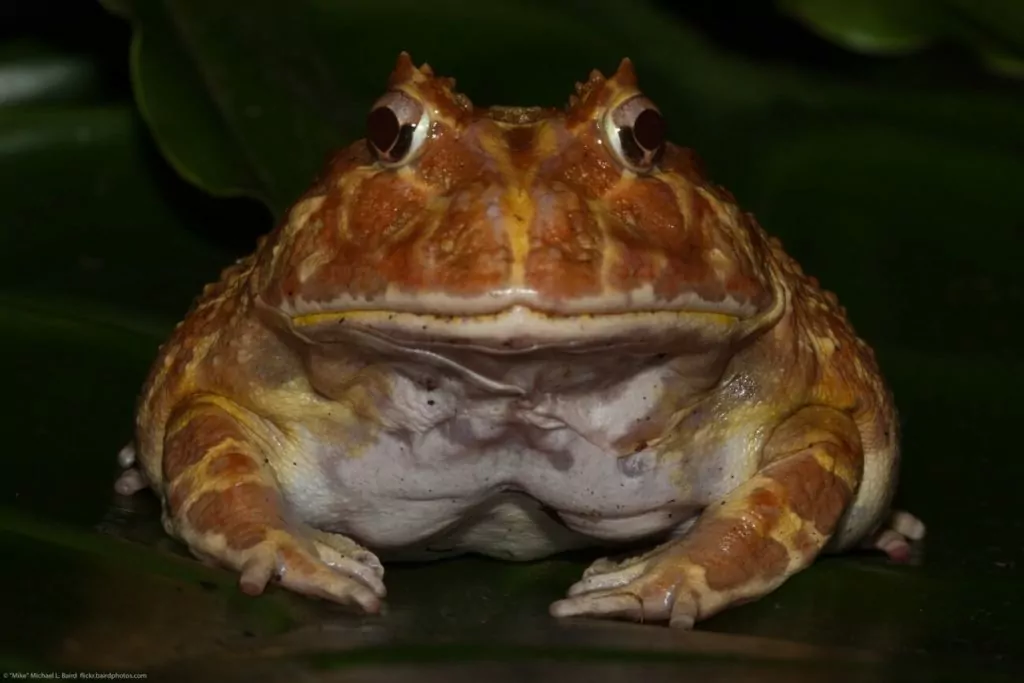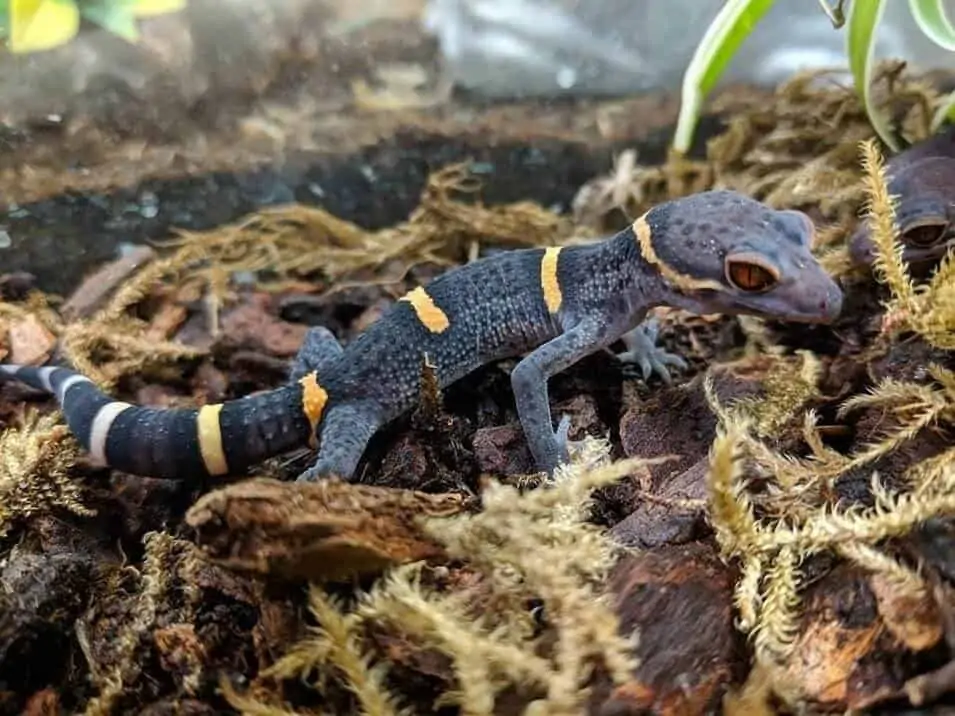Carpet chameleons are an interesting-looking pet reptile that are quite underrated. These creatures are very fun to own, and only require an intermediate level of knowledge to be kept successfully.
Their beautiful colors and patterns are a sight to see, and you’ll never get tired of watching them!
But if you really want to own one, you should do your homework first.
This guide will teach you the fundamentals of carpet chameleon care. You’ll learn about their diet, enclosure preferences, lifespan, size, and more!
Table of Contents
Species Summary
The carpet chameleon (Furcifer lateralis) is an arboreal chameleon native to the mixed woodlands of Madagascar. This chameleon is also sometimes referred to as the jeweled chameleon.
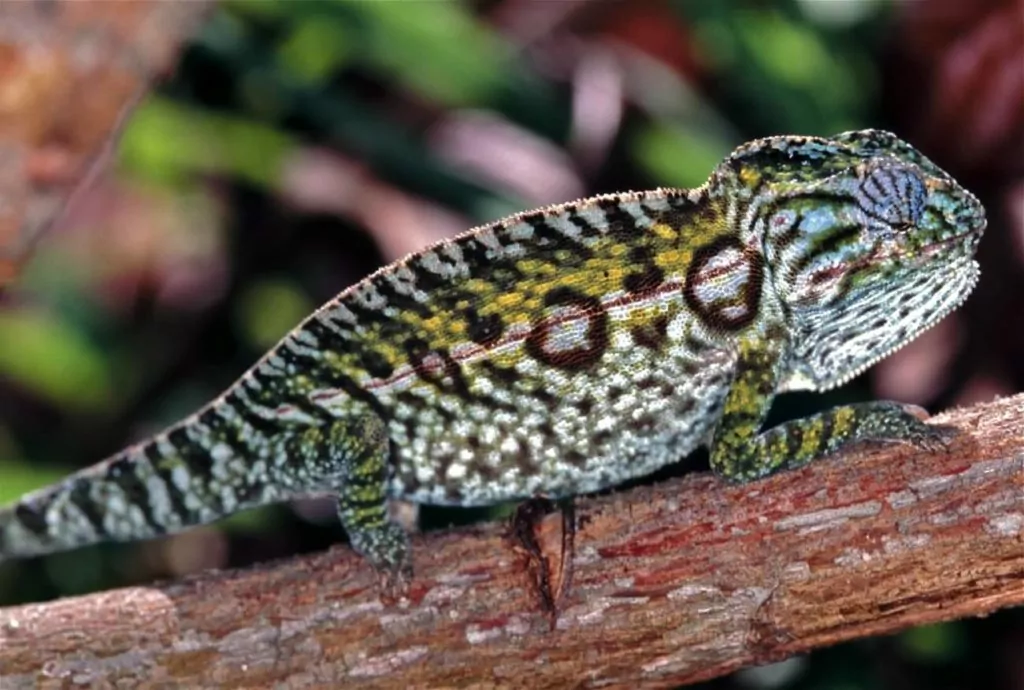
This intricately colored chameleon has a sensitive nature and can be prone to stress. Because of this, we highly recommend that only those with an intermediate to advanced knowledge of reptile husbandry attempt to care for this particular type of chameleon.
Appearance & Colors
Carpet chameleons are highly prized for their stunning coloration. In fact, legend has it that their name comes from their resemblance to an intricately woven Oriental carpet.
Male carpet chameleons are a vivid, almost lime green color. Females, however, are an absolute riot of colors including patterns of green, white, yellow, orange and even red. Both males and females have a striped pattern on their throats.
Expert Tip: Contrary to what you may have heard, these chameleons do not change color to match their surroundings. Color changing, which can take place right before your eyes, is solely dependent on the mood of the chameleon or on changes in its environment.
Carpet Chameleon Lifespan
The average carpet chameleon lifespan is about three years. Of course, some can live longer than that, but you need an element of luck and genetics for that to happen (even with great care).
Sometimes people are critical of carpet chameleons because their lifespan isn’t as long as some other popular pet reptiles. With a good set up, regular vet visits and meticulous care, carpet chameleons born in captivity can live a fairly long, and very happy life (which is just as important).
Average Size
The average carpet chameleon size is between six and ten inches long. That makes this species one of the smallest among common pet chameleon varieties.
Since most carpet chameleons measure about four inches from snout to vent, half of the total length comes from the tail. In terms of body girth, females tend to have a heavier body structure than males (which isn’t uncommon for reptiles).
Carpet Chameleon Care
Carpet chameleon care is usually a good fit for owners with an intermediate to advanced level of expertise. While they’re not considered to be the most difficult reptiles to care for, there are some specific hurdles you’ll need to navigate.
These chameleons tend to be quite nervous, shy and easily stressed, so they are going to require a very specific setup, lots of patience and the ability to just be themselves.
A good working knowledge of their heat and lighting requirements as well as their dietary needs is also critical for the long term happiness and health of your carpet chameleon.
Enclosure Size
If you do decide to purchase a carpet chameleon, you need to make sure that you get the size and type of enclosure just right.
An enclosure of 18″x18″x36″ is the standard recommended size, but feel free to make the living space even larger. Your carpet chameleon will appreciate lots of things to climb on and places to hide, so a larger vivarium will let you create an enclosure that is as close to their natural habitat as possible.
Because carpet chameleons need good enclosure ventilation, many owners use a full screen enclosure. Screen enclosures will provide ventilation, but these enclosures will need to be misted more often, and they will require a stronger basking light.
Glass terrariums are another option for carpet chameleon care since they retain humidity and temperature more easily than a full screen enclosure. At the end of the day, it really comes down to your preference between the two.
Habitat Setup
Making your carpet chameleon feel happy and safe within their enclosure should be a top priority. This means that you’ll need to put in a bit of effort to create a well-planned living space that’s full of things to climb on as well as plenty of live foliage.
Designing this living space can be lots of fun, and you can really let your creative side shine. After all, the enclosure you make is something that can be enjoyed by both you and your chameleon.
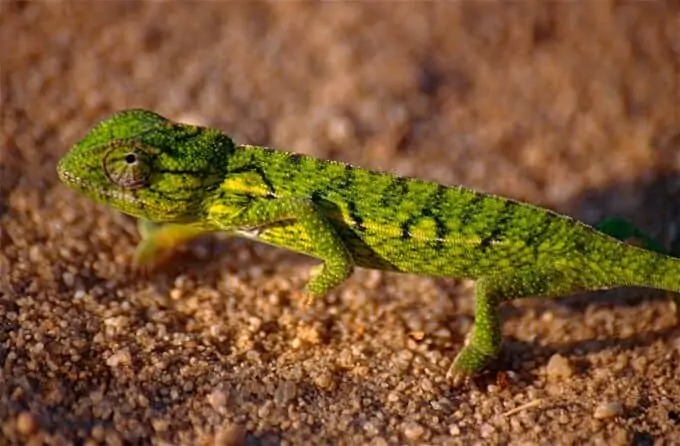
Because carpet chameleons spend a good amount of their day basking, you’ll want to place lots of different sized sticks and branches throughout your enclosure. Some of these branches should be placed vertically and some horizontally.
Foliage provides your chameleon with a place to hide, cool off or just relax. Plants also help to maintain proper humidity levels. Using a combination of live plants is the best way to create the natural environment your carpet chameleon craves. Weeping fig, Golden Pothos, Dracaena compacta and Hibiscus are excellent, easy to grow options.
The substrate you use is pretty important, so a bit of planning is going to be necessary.
You’re going to need at least two inches of some type of gravel, such as pea gravel, on the bottom of the enclosure. Next should come drainage fabric with about three inches of soil mixture on top. Half peat moss, half sand is fine for this layer.
Expert Tip: After placing the live plants into the soil, you will have to put a layer of dead leaves on top of the soil layer. This is the final touch that will complete the natural vibe of the enclosure.
Temperature & Lighting
Carpet chameleons have very specific requirements when it comes to heating and light. Because they’re not able to self-regulate their body temperature (like all reptiles), carpet chameleons need to have a place to get warm and a place to relax and cool down.
This is called a heat gradient, and it’s critical to your chameleon’s health. Here are the temperatures you need to know:
- The ambient temperature of the enclosure needs to remain between 76°F and 82°F
- Keep their basking area at a toasty 85°F to 88°F
- Nighttime temperatures can go as low as 64°F to 72°F
A great way to provide heat is to use reptile heat pads in the bottom of the enclosure. This will ensure 24 hour heat. Halogen puck lights are another popular way to provide the required amount of heat. Make sure to not use too many of these lights, or the enclosure could become too hot.
In the wild, carpet chameleons get all the sunlight they need. However, carpet chameleons in captivity often don’t get the necessary amount of light to maintain proper health. This is when the use of a UVB bulb becomes absolutely necessary. Combining a fluorescent light with a UVB bulb can give your chameleon the various types of lighting they need.
Expert Tip: Stick to a 12 hour on, 12 off lighting cycle to ensure that your carpet chameleon fully benefits from your lighting setup.
Humidity
The humidity level inside your chameleon enclosure should be maintained at 50 or 60 percent. In order to maintain this level of humidity, you will need to hand mist the enclosure two to three times each day.
It’s important to remember that the goal of misting should be to make the ground damp, not wet.
If you want to streamline the process a bit, the easiest way to maintain the correct amount of humidity is to use an automatic mister. A mister provides the nice, fine mist that your chameleon likes, and it makes it easy to keep the enclosure at the right humidity level.
Water
Your carpet chameleon needs lots of water. Fortunately, this water can be provided by the misting methods mentioned above. Chameleons do not like to drink from bowls and will get their water from water droplets in their environment.
Heat lamps will cause your hand-misted water to dry up very quickly. It’s very important to monitor the water and humidity inside the enclosure.
Food & Diet
Don’t be fooled by the small size and cute appearance of your carpet chameleon. This reptile is an efficient hunter and has a healthy carnivorous appetite.
We recommend feeding your chameleon a selection of items such as fruit flies, house flies, crickets and bean beetles. You can also give them mealworms, super worms and a variety of roaches. Feeding your chameleon six to seven days a week is optimal, but you should always dust the prey with calcium and vitamin powders before feeding time.
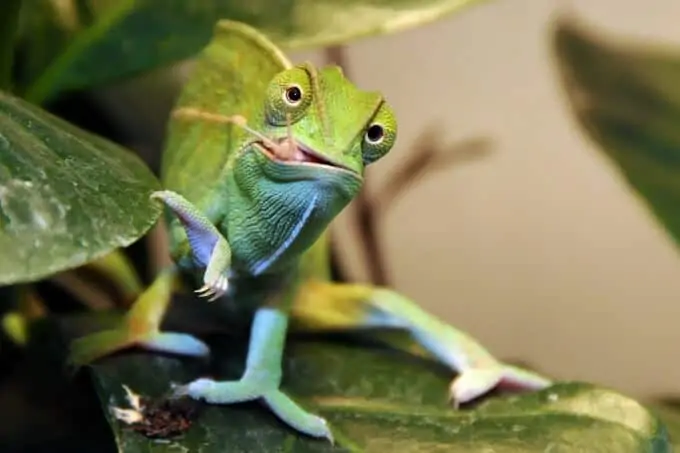
It’s important to never give your carpet chameleon insects straight from the supply store. This is because store bought prey is rarely gut loaded.
Gut loading is the process of making the prey as nutritious as possible. By gut loading the prey a few days before feeding time, you’ll be able to provide your chameleon with lots of good nutrition.
Expert Tip: You should never put your carpet chameleon’s food in a food bowl. Their tongues are like suction cups and can get stuck on the bowl. In a worst case scenario, this can cause permanent damage to the tongue. If this happens, your pet may never be able to eat properly.
Potential Health Issues
If you own a carpet chameleon, your relationship with your veterinarian is going to be very important. These animals are subject to a variety of health issues that can become serious if not treated immediately. Some of these issues include:
Issue 1: Parasites can be a big issue for carpet chameleons. An infestation of parasites can quickly get out of hand, so an annual vet visit is very important. Your vet will do fecal and blood tests to check for any harmful parasites.
One way to prevent parasites is to never give your carpet chameleon wild food. Store bought prey is less likely to harbor dangerous parasites.
Issue 2: Like many reptiles, your carpet chameleon is very susceptible to upper respiratory infections. These infections are usually caused by some kind of disruption in the environment of the enclosure. This is why it’s so important to carefully monitor the conditions of the enclosure.
Signs of a respiratory infection include extra mucus, bubbling near the nose and mouth or wheezing.
Issue 3: Metabolic bone disease, due to a lack of proper UVB lighting, is preventable. Because your carpet chameleon does not get the correct amount of natural lighting in captivity, it can quickly develop a Vitamin D3 deficiency. By providing UVB lighting, you can prevent your pet from getting this debilitating health issue.
Signs that your chameleon could be suffering from metabolic disease include clumsiness, bowed legs and troubles with the tongue.
Issue 4: Carpet chameleons often suffer from kidney failure. This is another preventable issue that is caused by a lack of moisture in the enclosure. Humidity levels should not go below 50 percent, and there should always be enough water available. Careful monitoring and responsible husbandry will prevent this unnecessary illness from happening.
Issue 5: Lastly, stress can lead to immune system problems. This can be avoided by keeping your chameleons in a quiet, stress-free area.
Behavior & Temperament
Carpet chameleons are sweet, shy reptiles, and they need plenty of space within their enclosure where they can go to hide and feel safe. Do not handle these reptiles too much because this can cause unnecessary stress (more on that below).
Male carpet chameleons are very territorial and do not like to be in an environment with other males. It’s highly recommended that you keep males in separate enclosures.
Handling Them
The rule of thumb with carpet chameleons is to minimize handling as much as possible. You should not get this pet reptile if you’re looking for something to snuggle with.
As much as you may want to pick up and hold your adorable little pet, it’s always best to let their natural preferences be your guide. Some carpet chameleons will be more tolerant than others, but even they will prefer very little handling.
Conclusion
Carpet chameleon care can be rather straightforward once you get comfortable with their priority requirements. Once you have a good rhythm, the entire process will become second nature.
Let us know if there’s any other carpet chameleon info that you would like us to add to this guide. We’re always open to making improvements!

